By JIALEI TANG, 5/11/2016. The semester is ending and as my finals conclude one after another, my mind can draw more attention to my study that is about to commence. With advice from Professors Brian McGrath, David Leven and Lei Ping, I am in extremely good hands to execute my study of architecture, homeliness and homebuilding.
This is an issue that most native inhabitants of emerging economies are facing — the erosion of familiarity in hometowns. Places, whether they are villages, towns or cities in their own right, are superimposed with western iconography of a “modern city”. Concrete, steel and glass take over the landscape and engulf the local cultural integrity. As the identity is displaced, the home becomes unfamiliar.

A temporal comparison of housing would be quite adequate to bring out the contrast between local and the misguided sense of “modern”. I am also looking to see if the dichotomy between the two is a misconception. Perhaps progress and heritage are not mutually exclusive? Furthermore, in places that such a coexistence occurs, such as Hangzhou, what are the challenges that it faces?
Professor Brian McGrath, who is especially knowledgable about Hangzhou, has told me that the overwhelming tourism has torn the inherent social fabric. Professor Lei Ping has also shared that preserved landmarks such as Houhai, Tianzifang face similar problems. Tianzifang, an area of preserved Shikumen architecture, is no longer residential, as it was originally intended, but a commercial tourist hotspot. This is important to note and must be addressed in my study as well. For one, it may serve as an antithesis — that the heritage imprint may not preserve the sense of home if it becomes commodified and commercialized. However, it may also help my argument because the large attraction of tourism it draws suggests that heritage means a lot to people — the domestic Chinese and foreigners alike. If more places are able to preserve their cultural heritage, then there is less need to flock to officially protected landmarks to appreciate vernacular architecture.
It is not an easy question to answer and I can only hope to open more questions with my inquiries.
